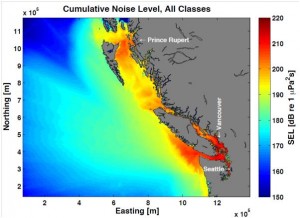
We recently partnered with two acousticians, Christine Erbe of Curtin University and Alex MacGillivray of JASCO, to predict how BC’s waters sound to a whale. Using shipping traffic data compiled by Patrick O’Hara (which we used previously in a ship strike analysis for fin, humpback and killer whales), and making some assumptions about how noisy ships are at different speeds, Christine and Alex were able to predict how much noise different parts of BC experience throughout the year.
What we found is that while ship noise comes and goes, human activities are carving persistent acoustic features into the ocean soundscape, because shipping lanes are entrenched.
The good news is that some areas, particularly some of the mainland inlets on BC’s north central coast, are still comparatively quiet. It may be that the tangle of islands, fjords and narrow passageways, buffer the ability of anthropogenic ocean noise to propagate up into those inlets, some of which remain in a bit of an acoustic shadow. Armed with this new information, perhaps Canadians would like to manage human activities in such a way as to maintain these sites as acoustic sanctuaries — marine wilderness areas that remind us what the ocean used to sound like decades ago, when whales were the loudest features of the soundscape.
We enjoyed working on this project, which was supported by WWF-Canada. Please see what WWF had to say about our study, and check out the original article, which is published in the open-access {FREE!} journal, Journal of the Acoustical Society of America Express Letters.
